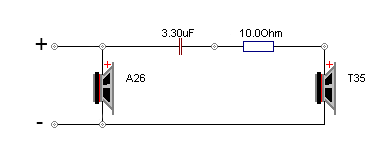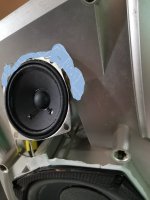Ok so here is my final config
3.3uf capasitor in line with tweeter(4ohms 2.5inch 20w) connected with subwoofer in parallel
Subwoofer connected in series with inductor 0.11mh(8ohms 5.25 inch Impedance 8 Ohms
Res. Freq. 65 Hz
Nominal Power 70 Watt (RMS 49W)
Max Continuous Power 180 Watt
Spike Power 350 Watt (Will short at this power, after few seconds)
Sensitivity (2.83V/1m) 89db
DC Resistance 7.7 Ohms
Qms 3.52
Qes 0.87
Qts 0.69
BL(motor strength) 7.3Tesla-Metre
VAS 4.99 Litres
Voice Coil Dia 29mm/4 layer winding
Magnet 90x17mm
Chassis CR steel, Galvanised.)
Crossover frequency 6000hz
This all looks good or any changes
3.3uf capasitor in line with tweeter(4ohms 2.5inch 20w) connected with subwoofer in parallel
Subwoofer connected in series with inductor 0.11mh(8ohms 5.25 inch Impedance 8 Ohms
Res. Freq. 65 Hz
Nominal Power 70 Watt (RMS 49W)
Max Continuous Power 180 Watt
Spike Power 350 Watt (Will short at this power, after few seconds)
Sensitivity (2.83V/1m) 89db
DC Resistance 7.7 Ohms
Qms 3.52
Qes 0.87
Qts 0.69
BL(motor strength) 7.3Tesla-Metre
VAS 4.99 Litres
Voice Coil Dia 29mm/4 layer winding
Magnet 90x17mm
Chassis CR steel, Galvanised.)
Crossover frequency 6000hz
This all looks good or any changes
Your cross is very high at 10kHz. Your woofer will be doing nothing up there, the inductor will not help.(3.3uf,22uf,10uf)
Since you have all these capacitors, you could use them to run your small fullrange down to 1kHz. You'll want to listen and make a choice. Don't forget to make it more quiet if you need to, using a resistor.
So, we're basically talking about matching a 5.25" woofer with a 2.5" tweeter.
As you've said in post #12, run the woofer direct from the amplifier terminals and add the tweeter via a series bipolar (non-polar) capacitor.
The crossover to the 4 ohm tweeter will have to occur at quite a low frequency, so experiment with much larger values than 3.3 uF.
A 22 uF capacitor will give you a crossover frequency of around 2 kHz, while a 33 uF would get you closer to 1 kHz.
As AllenB points out, you may need to include a wirewound resistor of around a few ohms if the tweeter sounds too loud. Connect it as shown in the diagram below.
As you've said in post #12, run the woofer direct from the amplifier terminals and add the tweeter via a series bipolar (non-polar) capacitor.
The crossover to the 4 ohm tweeter will have to occur at quite a low frequency, so experiment with much larger values than 3.3 uF.
A 22 uF capacitor will give you a crossover frequency of around 2 kHz, while a 33 uF would get you closer to 1 kHz.
As AllenB points out, you may need to include a wirewound resistor of around a few ohms if the tweeter sounds too loud. Connect it as shown in the diagram below.
Attachments
Last edited:
What I said is how Kenwood orginal bookshelf speaker setup a tweeter with inline capasitor 3.3uf and a woofer directly connected to amplifier
What if I use small tweeters 2 inch which were past used i changed them with 2.5 inch as old were not working i kept the ohms same.
So this will work or there is no issue any size tweeter is ok
So this will work or there is no issue any size tweeter is ok
You will have to give full details of the actual tweeter you intend to use.
Supply a link to its specifications, or at least supply photographs if it (front and rear).
There is an issue with the size of tweeter you choose to use as a small one would not like being crossed as low as your 2.5" satellite speaker.
Supply a link to its specifications, or at least supply photographs if it (front and rear).
There is an issue with the size of tweeter you choose to use as a small one would not like being crossed as low as your 2.5" satellite speaker.
woofer pic
I asked for a tweeter pic!
Kenwood amplifier
The specs of your now replaced Kenwood amplifier are of little interest when it comes to crossing over your tweeter.
...small tweeters 2 inch which were past used i changed them with 2.5 inch as old were not working i kept the ohms same.
So this will work or there is no issue any size tweeter is ok
Thanks for the pics.
You seem to be saying that the 2" tweeters no longer work so I presume you will use the 2.5" drivers from your "satellite speakers".
If that is the case, simply experiment with the series capacitor value till the speaker system sounds right.
10 uF will give you a crossover frequency of 4 kHz and I suggest you try that first.
What I think is previous I had 2 inch tweeter, replacement i bought 2.5 inch tweeter so why not use same 3.3 uf capasitor. will it not work with new one some other reasons. as woofer is handling vocals as well as bass it's a full range drive. We can Focus on highs
Attached new tweeter pic 2.5 inch,
If 3.3uf capasitor sound good with 2 inch twetter I can replace 2.5inch with 2 inch
Attached new tweeter pic 2.5 inch,
If 3.3uf capasitor sound good with 2 inch twetter I can replace 2.5inch with 2 inch
Attachments
You can crossover the 2.5 inch driver in your picture at a much lower frequency than the 2.0 inch tweeter.
A 3.3 uF capacitor will give a high crossover frequency of 12 kHz with a 4 ohm driver.
10 uF will give a lower crossover frequency of 4 kHz with a 4 ohm driver, which is probably the better choice in your case.
I suggest you experiment with the capacitor value. I can't think of anything to add.
A 3.3 uF capacitor will give a high crossover frequency of 12 kHz with a 4 ohm driver.
10 uF will give a lower crossover frequency of 4 kHz with a 4 ohm driver, which is probably the better choice in your case.
I suggest you experiment with the capacitor value. I can't think of anything to add.
Yes, this can work. It is not subwoofer and tweeter.. it is midwoofer and tweeter. This is easier on the impedance.What I said is how Kenwood orginal bookshelf speaker setup a tweeter with inline capasitor 3.3uf and a woofer directly connected to amplifier
Time to try it. Tell us what you don't like about it, then it might be easier to make suggestions.
There may be a slight complication.
If the 2.5" driver has an open back (and not a closed back like the 2" tweeter) it will have to be boxed in if it is to be placed inside the woofer enclosure.
Otherwise, the 2.5" driver cone will be subjected to the back pressure of the vibrating woofer cone.
Perhaps a photo showing the rear view of the 2.5" driver would be a good idea?
If the 2.5" driver has an open back (and not a closed back like the 2" tweeter) it will have to be boxed in if it is to be placed inside the woofer enclosure.
Otherwise, the 2.5" driver cone will be subjected to the back pressure of the vibrating woofer cone.
Perhaps a photo showing the rear view of the 2.5" driver would be a good idea?
Yes you are right my 2.5 inch speaker has open back i can see spider moving but will it make much difference, we have two different compartments for tweeter and woofer
Tweeter is connected outside in open air and woofer is concealed in and has separate opening for bass air out
But yes we can see lot of vibration my whole bookshelf speaker vibrates.
Tweeter is connected outside in open air and woofer is concealed in and has separate opening for bass air out
But yes we can see lot of vibration my whole bookshelf speaker vibrates.
- Home
- Loudspeakers
- Subwoofers
- I have a passive subwoofer need low pass filter


